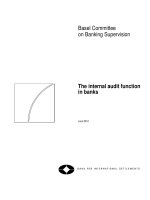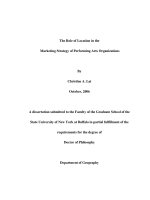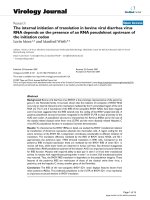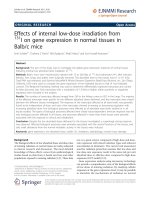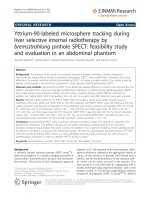Internal fault location in transformer Windings(TQL)
Bạn đang xem bản rút gọn của tài liệu. Xem và tải ngay bản đầy đủ của tài liệu tại đây (1.32 MB, 79 trang )
Western Michigan University
ScholarWorks at WMU
Master's Theses
Graduate College
4-2016
Internal Fault Location in Transformer Windings
Samir Yehya Abed-Alkareem Alzekri
Western Michigan University
Follow this and additional works at: />Part of the Electrical and Computer Engineering Commons
Recommended Citation
Abed-Alkareem Alzekri, Samir Yehya, "Internal Fault Location in Transformer Windings" (2016). Master's Theses. 682.
/>
This Masters Thesis-Open Access is brought to you for free and open access
by the Graduate College at ScholarWorks at WMU. It has been accepted for
inclusion in Master's Theses by an authorized administrator of
ScholarWorks at WMU. For more information, please contact
INTERNAL FAULT LOCATION IN TRANSFORMER WINDINGS
by
Samir Yehya Abed-Alkareem Alzekri
A thesis submitted to the Graduate College
in partial fulfillment of the requirements
for the degree of Master of Science in Engineering (Electrical)
Electrical and Computer Engineering
Western Michigan University
April 2016
Thesis Committee:
Pablo Gomez, Ph.D., Chair
Johnson Asumadu, Ph.D.
Ralph Tanner, Ph.D.
INTERNAL FAULT LOCATION IN TRANSFORMER WINDINGS
Samir Yehya Abed-Alkareem Alzekri, M.S.E.
Western Michigan University, 2016
Power transformers are one of the most important components in electrical power
systems. During their lifetime they are exposed to various electrical faults which are
originated from transient overvoltages, electromagnetic forces due to over-currents,
ageing, etc.
Internal winding faults are among the most common causes of transformer failure.
Once a fault occurs, a fast an efficient method for its detection and location is required to
avoid further delays in the network operation. This paper introduces a simple method for
the location of internal winding faults. This method is based on time domain terminal
measurements of wave propagation along the winding. By means of low-cost laboratory
components (a low-voltage DC source and an oscilloscope), different types of faults in
layer–type windings can be detected and located with high accuracy. A frequency-domain
distributed-parameter winding model is used to predict the transient response of the
winding subjected to different types of faults. FEM simulations are used to compute the
model parameters. A test case is presented to demonstrate the efficacy of the fault location
method.
© 2015 Samir Yehya Abed-Alkareem Alzekri
ACKNOWLEDGMENTS
I would like to express my sincere thanks for my advisor, Dr. Pablo Gomez, for
his advice and support throughout this work. He introduced me to the world of research
and encourage me to develop my own ideas for the problem while support me at each
step with his knowledge and advice. Working with him has been a valuable experience
for me and my continued education.
I would like to extend my thanks and appreciation to each member of my thesis
committee, Dr. Johnson Asumadu, Ralph Tanner, for reviewing my thesis and their
valuable suggestions. Lastly, my special thanks and gratitude go to my parents, my wife,
and my friends for their supports and understanding while in graduate school.
Samir Yehya Abed-Alkareem Alzekri
ii
TABLE OF CONTENTS
ACKNOWLEDGMENTS .................................................................................................. ii
LIST OF FIGURES ........................................................................................................... vi
CHAPTER
1 INTRODUCTION ........................................................................................................... 1
1.1 Objectives ................................................................................................................ 2
1.2 Justification ............................................................................................................. 2
1.3 State of the Art ........................................................................................................ 2
1.3.1
Transformer Models ........................................................................................ 2
1.3.2
Parameters Determination for Transformer Model ........................................ 4
1.3.3
Fault Detection Methods ................................................................................ 6
1.4
Contributions .......................................................................................................... 8
1.5
Limitations and Scope ............................................................................................ 9
1.5.1
Limitations ...................................................................................................... 9
1.5.2
Scope .............................................................................................................. 9
1.6
Thesis Outline .................................................................................................... 10
iii
Table of Contents - Continued
CHAPTER
2 TRANSFORMER WINDING MODELING FOR FAST TRANSIENT ANALYSIS . 12
2.1 Introduction ........................................................................................................... 12
2.2 Distributed Parameter Model ................................................................................ 14
2.2.1 Telegrapher Equations of Multiconductor Transmission Line ...................... 14
2.3 Lumped Parameter Model ..................................................................................... 19
2.3.1 Model Based on State Equation Without Series Losses ................................. 20
3 PARAMETER DETERMINATION FOR HIGH-FREQUENCY
ELECTROMAGNETIC TRANSIENTS ...................................................................... 22
3.1 Introduction ........................................................................................................... 22
3.2 Calculation of the Capacitance Matrix .................................................................. 22
3.2.1 Analytical Expressions ................................................................................... 23
3.2.2 Finite Element Method ................................................................................... 26
3.3 Calculation of the Inductance Matrix .................................................................... 28
3.3.1 Analytical Expressions ................................................................................... 28
3.3.2 Finite Element Method ................................................................................... 29
3.4 Calculation of Loss Components .......................................................................... 32
3.5 Case Study ............................................................................................................. 34
iv
Table of Contents - Continued
CHAPTER
4 INTERNAL FAULT ANALYSIS AND LOCATION .................................................. 37
4.1 Introduction ............................................................................................................. 37
4.2 Fault Detection Method ........................................................................................... 37
4.3 Test Case Result ...................................................................................................... 41
4.3.1 Short Circuit Fault between Neighboring Turns ............................................ 41
4.3.2 Open Circuit Fault .......................................................................................... 46
4.3.3 Short Circuit Fault between Neighboring Layers ........................................... 50
4.3.4 Comparison between Different Fault Types ................................................... 53
5 CONCLUSIONS AND FUTURE WORK .................................................................... 56
BIBLIOGRAPHY ............................................................................................................. 59
APPENDICES
A. COMSOL Results .............................................................................................. 64
B. The Numerical Inverse Laplace Transform ....................................................... 66
v
LIST OF FIGURES
2.1 Equivalent circuit per unit length of the winding of a transformer [27]..................…14
2.2 Admittance model for multiconductor transmission line [28]..................……….......18
2.3 MTL model of transformer windings [14]………………………………………...…18
2.4 Equivalent circuit of transformer winding including losses [30]...…………...…….. 19
3.1 Representation of two discs of transformer winding [27]………….…......................24
3.2 Mutual inductance between two thin wires [36]…………………….....................….29
3.3 Computing the self-inductance using flux linkage method [28]……...……….…..... 31
3.4 Computing the mutual inductance using flux linkage method [28]………………… 31
3.5 Turns connection for three layer transformer…………………………………….… 34
3.6 Meshing for calculation of the capacitance matrix……………………..................... 35
4.1 Propagation Speed Measurement for different permittivities ………..….................. 39
4.2 Flowchart for the general application of the fault location method…….....................40
4.3 Transient voltage response at the excitation node. Short circuit fault at layer 1.........43
4.4 Transient voltage response at the far-end node. Short circuit fault at layer 1…….... 43
4.5 Transient voltage response at the excitation node. Short circuit fault at layer 2...…..44
4.6 Transient voltage response at the far-end node. Short circuit fault at layer 2…….....44
vi
List of Figures – Continued
4.7 Transient voltage response at the excitation node. Short circuit fault at layer 3…….45
4.8 Transient voltage response at the far-end node. Short circuit fault at layer 3……….45
4.9 Transient voltage response at the excitation node. Open circuit fault at layer 1…….46
4.10 Transient voltage response at the far-end node. Open circuit faults at layer 1……..47
4.11 Transient voltage response at the excitation node. Open circuit fault at layer 2…...48
4.12 Transient voltage response at the far-end node. Open circuit fault at layer 2……...48
4.13 Transient voltage response at the excitation node. Open circuit faults at layer 3….49
4.14 Transient voltage response at the far-end node. Open circuit fault at layer 3……...49
4.15 Transient voltage response at the excitation node. Short circuit fault
between layers 1 and 2…………………………………………………………..….…...51
4.16 Transient voltage response at the far-end node. Short circuit fault between
layers 1 and 2……………………………………………………………..………..…….51
4.17 Transient voltage response at the excitation node. Short circuit faults
between layers 2 and 3……………………………………………………….…....52
4.18 Transient voltage response at the far-end node. Short circuit faults
between layers 2 and 3…………………...…………………………………….….52
vii
List of Figures – Continued
4.19 Transient voltage response at the excitation node. Faults at layer 1.......…………...54
4.20 Transient voltage response at the far-end node. Faults at layer 1…..........................54
4.21 Transient voltage response at the excitation node. Faults at layer 2…………….….55
4. 22 Transient voltage response at the far-end node. Faults at layer 2…………….........55
viii
CHAPTER 1
INTRODUCTION
The purpose of an electric power system is to provide electrical energy to all users
in a reliable and continuous manner. The electricity consumption has increased in recent
years because of the growth in population and the increased number of industries. This has
increased the complexity and the size of electric power systems.
Most of the time the systems operate in a steady state. However, it is very important
to study and analyze their behavior when a sudden change occurs. An electromagnetic
transient is one of these conditions and is due to the interaction between electric energy
stored in the capacitive elements and magnetic energy stored in the inductive elements of
the system. As a consequence of this condition, power components are subjected to electric
stresses which can result in operation failures [1].
Power transformers are one of the most important components in electrical power
systems. During their lifetime they are exposed to various electrical faults which are
originated from transient overvoltages, electromagnetic forces due to over-currents,
ageing, among other causes [2].
According to the 2014 IEEE Report to the DOE Quadrennial Energy Review on
Priority Issues, “25% of transmission infrastructure in the US is at an age where condition
is a concern” [3]. Among this aging infrastructure, transformers are recognized among the
1
most important and costly power devices. From the different components of the
transformer, between 30% and 50% of operating issues are related to winding damage [4]
[5]. These issues often result in open or short circuit faults at specific turns along the
windings. Once a fault occurs, a fast and an efficient method for its detection and
localization is required to avoid further delays in the network operation.
1.1 Objectives
To present a simple and accurate time domain method for the detection and
localization of internal faults in transformer windings, involving accessible and low-cost
laboratory equipment.
1.2 Justification
Most of the fault location methods available to date rely on frequency response
analysis (FRA) which, although very efficient, involves the application of highly
specialized and costly equipment (frequency response analyzers, network analyzers or
similar). Measurement setups using FRA can be time consuming and sensitive to the
integrity of connections and possible source of EMI. Besides, interpreting the frequency
response provided by these devices is a complicated task.
1.3 State of the Art
1.3.1
Transformer Models
In 1959, Rabins [6] introduced a new way to model a single layer transformer
winding by considering it as a multiconductor transmission line.
2
In 1997, Shibuya et al. [7] used a frequency domain model based on single phase
transmission line theory and multiconductor transmission line theory. They applied this
model to a disc type transformer winding. The results were compared with measurements.
Later, in 2001, Shibuya et al. [8] implemented a method to analyze high frequency
transients in power transformer by reducing the number of unknowns when applying the
multiconductor transmission line theory. The results were obtained using the fast Fourier
transform (FFT) and compared with experiment measurements. The comparison confirmed
the applicability of the method to the analysis of high frequency transients up to several
megahertz. A frequency domain lumped parameter model was used in 2002 by Shibuya
and Fujita [9] to analyze transient voltages in a transformer winding.
In 2001, Alfuhaid [10] presented a distributed parameter model in Laplace domain
for frequency domain analysis of a single phase two-winding transformer. This model takes
into account both the inductive and capacitive coupling between the two windings, and the
inter-turn coupling within each winding. The results were compared with those obtained
from the well-known circuit simulation program SPICE.
In 2006, Liang et al. [11] used a distributed parameter model based on
multiconductor transmission line theory to determine the transfer function. Vector fitting
and recursive convolution were used to obtain the response in time domain. The calculated
results were validated using an experimental measurement.
In 2007, Popov et al. [12] presented a frequency domain model for a layer type
transformer winding based on multiconductor transmission line theory. The iron core
3
losses and the proximity effect between layers were taken into account. The results were
verified by experimental measurements, demonstrating that the model can be used to
simulate the voltage distribution along the winding.
In 2008, Zhu et al. [13] presented a new hybrid model to simulate very fast transient
overvoltages. The windings were divided into three sections. The first section was modeled
based on multiconductor transmission line theory. A single phase transmission line was
used to represent the second part of the winding, and the third section of the winding was
modeled by equivalent lumped impedance. The results were validated with experimental
measurements.
In 2014, Villanueva-Ramírez et al. [14] implemented two time domain transformer
winding models for fast transient analysis using MATLAB/ Simulink. The first model is a
lumped parameter model based on state-space equations, and the second model is based on
multiconductor transmission line theory and Bergeron’s method. Series losses were
included in both models.
1.3.2
Parameters Determination for Transformer Model
In 1992, de Leon et al. [15] presented an efficient procedure for computing
transformer parameters (turn leakage inductances and capacitances). The turns were used
as a calculation base to allow modeling at very high frequencies. Turn-to-turn leakage
inductances were obtained using the method of images. The capacitances between turns
and turns to ground were calculated using the charge simulated method. This method was
4
validated by comparison with short circuit inductances computed with the finite element
method and classical design formulas.
In 2005, Yan et al. [16] presented a method for inductance calculation of power
transformers. This method is based on the transformer’s magnetic circuit, and considers
mutual and leakage inductances. The effect of vertical and horizontal leakage flux was
considered. The results were compared with dynamic analog test.
In 2011, Li et al. [17] introduced a new method for computing the equivalent series
capacitance and inductance of a unit coil for transient analysis of large transformers, using
the FEM-based software Ansoft Maxwell. An electrostatic field solver and a 2D
geometrical model were used for calculating the distributed capacitance of the winding,
while a static magnetic field module and a 3D geometrical model were used to compute
the inductance.
Also in 2011, Gomez et al. [18] presented a technique to compute the inductance
matrix of transformer windings for a very fast transients. This technique is based on the
application of a multilayer method of images, and is able to take the effect of the core into
consideration when computing the inductance matrix. The results were compared with an
electromagnetic field simulation using FEM, and showed an excellent accuracy. In 2013,
Gomez et al. [19] introduced an improvement to the previous method for calculating the
inductance matrix of multilayer windings.
5
In 2012, Eslamian et al. [20] used a new analytical method for computing the
inductance matrix for transformer winding at high frequencies. The effect of the core was
taken into considered. The inductance outside the core was computed by a numerical
integration of the potential vector. The core was replaced by an image source with the
correct magnitude and location. Two different methods based on an analytical solution of
the Poisson equation in planar coordinates were used to calculate the inductance inside the
core window. In both methods, the inductances were computed by applying the magnetic
energy method.
1.3.3 Fault Detection Methods
In 2001, De et al. [21] proposed a method for fault detection in power transformers
involving an artificial neural network as a pattern recognition technique to recognize the
frequency response of the winding admittance of a typical high voltage transformer under
healthy and different faulty conditions of winding insulation. A lumped parameter high
frequency model of the winding, based on a coil-by-coil representation of the windings,
was used and developed using EMTP. Discrete fast Fourier transformation (DFFT) was
used to convert the amplitude time data into the corresponding amplitude frequency
spectrum of the waves in form of vectors.
In 2004, Zhang et al. [25] proposed a method for insulation fault detection of power
transformers using the genetic programming (GP) method. The proposed method was
implemented using database of actual gas records from transformers. This database
consists of 352 gas records and their actual fault type diagnosed by experts. Only five fault
6
types were included in this database (no fault, medium temperature thermal, high
temperature thermal, low energy discharge, and high energy). Four genetic programming
classifiers (GPC) were generated by GPQUICK software to classify the five types of faults.
In 2007, Nandi [22] proposed a technique to detect the inter-turn faults by utilizing
the saturation effects of the transformer core. The sensitivity even for one turn fault is very
high. However, it requires to compare with information for the healthy transformer. This
method was verified using both simulation and experiments on a bank of three single phase
transformers.
In 2007, Yadaiah et al. [23] presented a methodology for off-line and on-line fault
detection in power transformers. An artificial neural network was used to detect off-line
faults and a discrete wavelet transforms to detect on-line faults. An artificial neural network
method based on dissolved gas analysis was used to overcome the limitations of existing
methods. The discrete wavelet transform for on-line fault detection involves measurement
of the current signal at the primary terminal of the power transformer and determines the
detail and approximate coefficients of discrete wavelet transform. These coefficients
characterize the condition of the system.
In 2014, Mahvi et al. [2] presented a new technique for sensitive detection and
localization of shorted turns on the windings. Using genetic algorithm, the detailed model
of the damaged winding by the fault is estimated from the measured low frequency
response data up to 10 kHz. The fault is localized along the winding by comparing between
the healthy and faulty transfer functions of the winding using statistical indicators. This
7
method was tested on transformer damaged by a low level short circuit fault. The results
showed that this method is sufficiently able to detect and localize failures due to shorted
turns on the transformer windings.
In 2015, Aljohani et al. [24] presented a way to identify the minimum level of a
short circuit fault within power transformers that can be detected using frequency response
analysis (FRA) technique. The model used in this paper is a physical geometrical
arrangement of a three phase transformer, using three dimensional finite element analysis
to simulate its physical operational conditions. Short circuit faults at different levels were
simulated, comparing the faulty response from the FRA with the healthy response. The
results showed that there is a minimum detection level of a short circuit fault that can be
detected using FRA technique. Results showed that short circuit fault levels higher than
5% can be identified using the FRA technique.
1.4 Contributions
An alternative time domain method for fault detection in layer type transformer
winding is proposed.
Unlike existing fault location techniques, the proposed method requires only low
cost, readily available and easy to use equipment: a low voltage DC source and an
oscilloscope with two channels.
A flow chart, based on extensive simulations on a distributed parameter model
defined in the frequency domain, was produced as a guide to apply the proposed
method.
8
1.5 Limitations and Scope
1.5.1
Limitations
The proposed time domain method for fault detection in transformer winding is
restricted to layer type transformers. Further tests are required to extend the method
to other winding configurations.
The method is able to detect three types of faults:
1. Short circuit between neighboring turns
2. Short circuit between neighboring layers
3. Open circuit
The results have not been validated experimentally. However, the model used to
test the fault location method has been previously validated by other authors.
1.5.2
Scope
The transformer winding model used to define and test the proposed method is a
distributed parameter model defined in the frequency domain. This model was
implemented using MATLAB.
Regarding the computation of electrical parameters required by the transformer
winding model: the capacitance matrix was obtained using the commercial
software COMSOL Multiphysics (based on the finite element method), while the
inductance matrix and losses were computed using analytical formulas.
9
The accuracy of the fault location method was assessed considering a 303-turns
layer type transformer winding model and applying different types of faults at
diverse locations along the winding.
1.6 Thesis Outline
Chapter 1, Introduction: This chapter includes introduction, objectives, justification,
limitations, and contributions of this thesis. In addition, the state of art on the subject is
presented.
Chapter 2, Transformer Winding Modeling for Fast Transient Analysis: The model
applied for the development and testing of the proposed fault detection method is described
in this chapter. A comparison between the lumped and distributed parameter models is also
included, as well as a discussion of the advantages of using a distributed parameter model.
Chapter 3, Parameter Determination for High-Frequency Electromagnetic Transients:
Several methods for calculating the parameters of high frequency transformer model are
described in this chapter. Furthermore, a case study for computing the parameters of a
transformer winding using commercial software COMSOL Multiphysics is introduced.
Chapter 4, Internal Fault Analysis and Location: The proposed method for fault
detection and location in transformer windings is introduced in this chapter. Also, the
simulation results for different type of faults at different locations and the ability of the
method to diagnose and localize the fault is demonstrated.
10
Chapter 5, Conclusion and Future Work: The main results and achievements of this
thesis are summarized, indicating possible future work.
11
CHAPTER 2
TRANSFORMER WINDING MODELING FOR FAST TRANSIENT ANALYSIS
2.1 Introduction
An electromagnetic transient is a sudden change in a circuit condition due to the
interaction between electric energy stored in the capacitive elements and magnetic energy
stored in the inductive elements. This phenomenon can occur in a power component or
system as a consequence of a switching operation, a lightning event or a fault condition.
After transmission lines, power transformers are the elements of the system with the
highest exposure to electromagnetic transients [26]. These phenomena can be classified,
according to the frequency content of the resulting surges, in low to mid-frequency
transients (slow-front surges), and high-frequency transients (fast-front surges). The type
of excitation applied for the fault detection method described in this thesis corresponds to
the latter classification. Therefore, the remaining of this Chapter describes the modeling
approach for high-frequency transients, also known as fast transients. Studying this
phenomenon by means of modeling and simulation tools usually requires the
implementation of very detailed models of the transformer winding considering a turn-byturn representation which includes inductive, capacitive and loss components [26]. Figure
2.1 shows a typical representation of a segment of a transformer winding [27], where L is
the series inductance of the winding, R is its series resistance, Cs is the capacitance between
turns, Rs is the loss component of Cs, Cg is the capacitance to ground, and Rg is the loss
12
component of Cg. Based on this circuit. Starting from this circuit, the most common
modeling approaches are based on applying circuit theory (lumped parameter models) or
transmission line theory (distributed parameter models). The models described in this
section are both defined in the frequency domain in order to consider the frequency
dependence of the winding parameters in a direct manner. The distributed parameter model
is based on a multiconductor transmission line representation and zig-zag connection to
preserve the continuity between conductors (turns) [28]. The lumped parameter model is
based on the nodal definition of a system consisting of N segments defined according to
Fig. 1.
When the length of each turn of the winding is far less than the wavelength, a turn
can be represented by a lumped element (lumped parameter model). This modeling
approach does not take into account the wave traveling along each turn. Therefore, it can
be inaccurate when the pulse applied has a very short rise time. This problem can be
overcome by using a distributed parameter model [29].
Taking into account the wave propagation along the winding allows a more
accurate transient analysis. This feature makes the distributed parameter model a better
candidate than the lumped parameter one for the fault detection method described in this
thesis.
13
i(z)
R∆z
L ∆z
i(z+∆z)
+
Cs/∆z
V(z)
V(z+∆z)
Rs/∆z
Cg ∆z
Rg/∆z
-
Figure 2.1 Equivalent circuit per unit length of the winding of a transformer [27]
2.2 Distributed Parameter Model
The ability to properly consider wave propagation along the winding and the
frequency dependence of the winding parameters are the most important advantages of
using a distributed parameter model defined in the frequency domain. For that reason, it is
considered as the most accurate model currently available [30]. In this model, each
conductor of a multiconductor transmission line model represents a turn of the winding.
The end of each conductor and the beginning of next conductor are connected to simulate
the continuity between turns of the winding [14].
2.2.1 Telegrapher Equations of Multiconductor Transmission Line
The telegrapher equations define the wave propagation along a transmission line.
They are defined in the time domain as [27]
−
𝜕𝐯(𝑧, 𝑡)
𝜕𝐢(𝑧, 𝑡)
= 𝐑 𝐢(𝑧, 𝑡) + 𝐋
𝜕𝑧
𝜕𝑡
14
(2.1)

